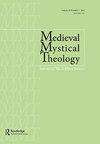Thomas Aquinas and Contemplation
IF 0.3
0 RELIGION
引用次数: 0
Abstract
process through which the subject is unified and transformed by Christ. However, Nelstrop qualifies her claim. Although she argues that Julian ‘accepted the idea of deification,’ for her, ‘this did not entail either the possibility of a this-worldly perfection or absorption into the Trinity’ (p. 127). Nelstrop wants to thus maintain the integrity of deification as a theme tied to Christ’s incarnation and the subject’s participation with that incarnational reality, without tying Julian to an account of deification which negates the boundary between creature and creator (p. 127). Following Jean Leclercq, Nelstrop argues that Julian echoes the monastic theological tradition which placed value on noting the aesthetic and emotional affects of a text (p. 131). This approach of intimately engaging the text gives rise to an awareness in the subject of an ‘inseparable independence on Christ’ (p. 146) and a growing understanding that God ‘is the ground of all that is’ (p. 155), the consequence of which is a subject transformed in the light of the knowledge of this intimate divine connection. Clarification of these claims and their link to lectio divina are given further account in chapter six. Nelstrop argues there, through an analysis of memory and biblical imagery, that Julian’s words and images can be understood as ‘the words and images of the Word’ (p. 238). Unity between the subject and God occurs here by developing practices which stress intimate engagement with the word itself. Nelstrop’s study, in conclusion, reveals that our grasp of medieval western notions of deification is granted greater clarity when classificatory models like those advocated by Russell are deployed. In doing so, we see that Julian and Rolle’s strategies of reading and techniques of writing suggest productive comparison with classical understandings of deification. Though, to be sure, further work on this topic is required to lend additional credibility to her thesis. Nelstrop’s text is a critical, thought-provoking, and important addition to our understanding of mysticism and deification in their medieval context.托马斯·阿奎那与沉思
通过这个过程,主体被基督统一和改变。然而,Nelstrop证实了她的说法。虽然她认为朱利安“接受了神化的想法”,但对她来说,“这并不意味着现世的完美或三位一体的可能性”(第127页)。因此,Nelstrop想要保持神化作为一个主题的完整性,这个主题与基督的化身和主体与化身现实的参与有关,而不是将朱利安与神化的描述联系起来,因为神化否定了生物和创造者之间的界限(第127页)。在Jean Leclercq之后,Nelstrop认为朱利安回应了修道院神学传统,该传统重视注意文本的美学和情感影响(第131页)。这种与文本密切接触的方法,使人们意识到“基督是不可分割的独立”(第146页),并日益认识到上帝“是一切存在的基础”(第155页),其结果是,在这种亲密的神圣联系的知识的照耀下,主题发生了变化。澄清这些主张及其与选举神圣的联系将在第六章进一步说明。Nelstrop认为,通过对记忆和圣经意象的分析,朱利安的话语和形象可以被理解为“话语的话语和形象”(第238页)。在这里,主体和上帝之间的统一是通过发展实践来实现的,这些实践强调与话语本身的亲密接触。总之,Nelstrop的研究表明,当采用罗素所倡导的分类模型时,我们对中世纪西方神化概念的理解变得更加清晰。在此过程中,我们看到朱利安和罗尔的阅读策略和写作技巧与经典的神化理解进行了富有成效的比较。不过,可以肯定的是,需要对这个主题进行进一步的研究,以增加她的论文的可信度。Nelstrop的文本是一个关键的,发人深省的,重要的补充,我们的神秘主义和神化在中世纪的背景下的理解。
本文章由计算机程序翻译,如有差异,请以英文原文为准。
求助全文
约1分钟内获得全文
求助全文

 求助内容:
求助内容: 应助结果提醒方式:
应助结果提醒方式:


